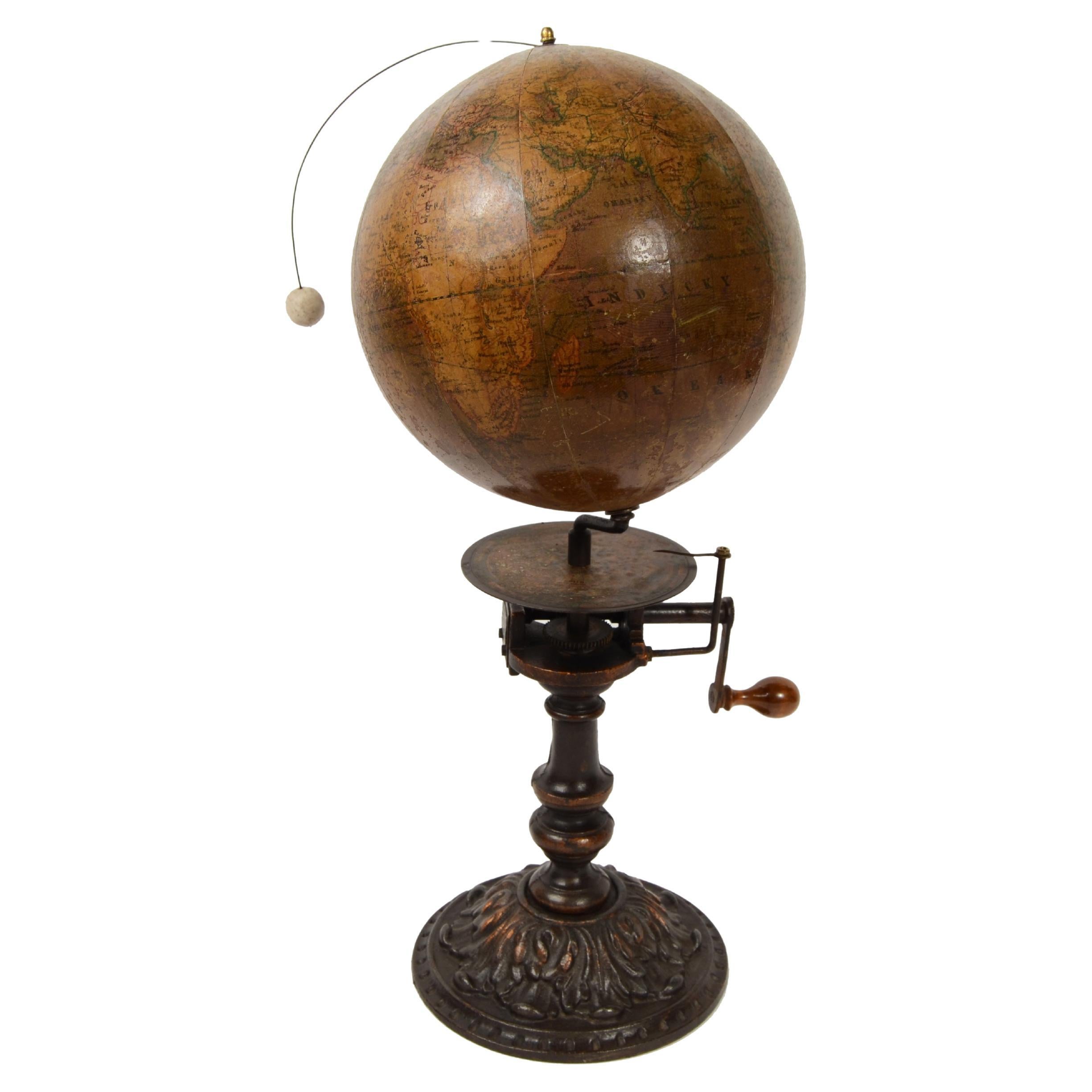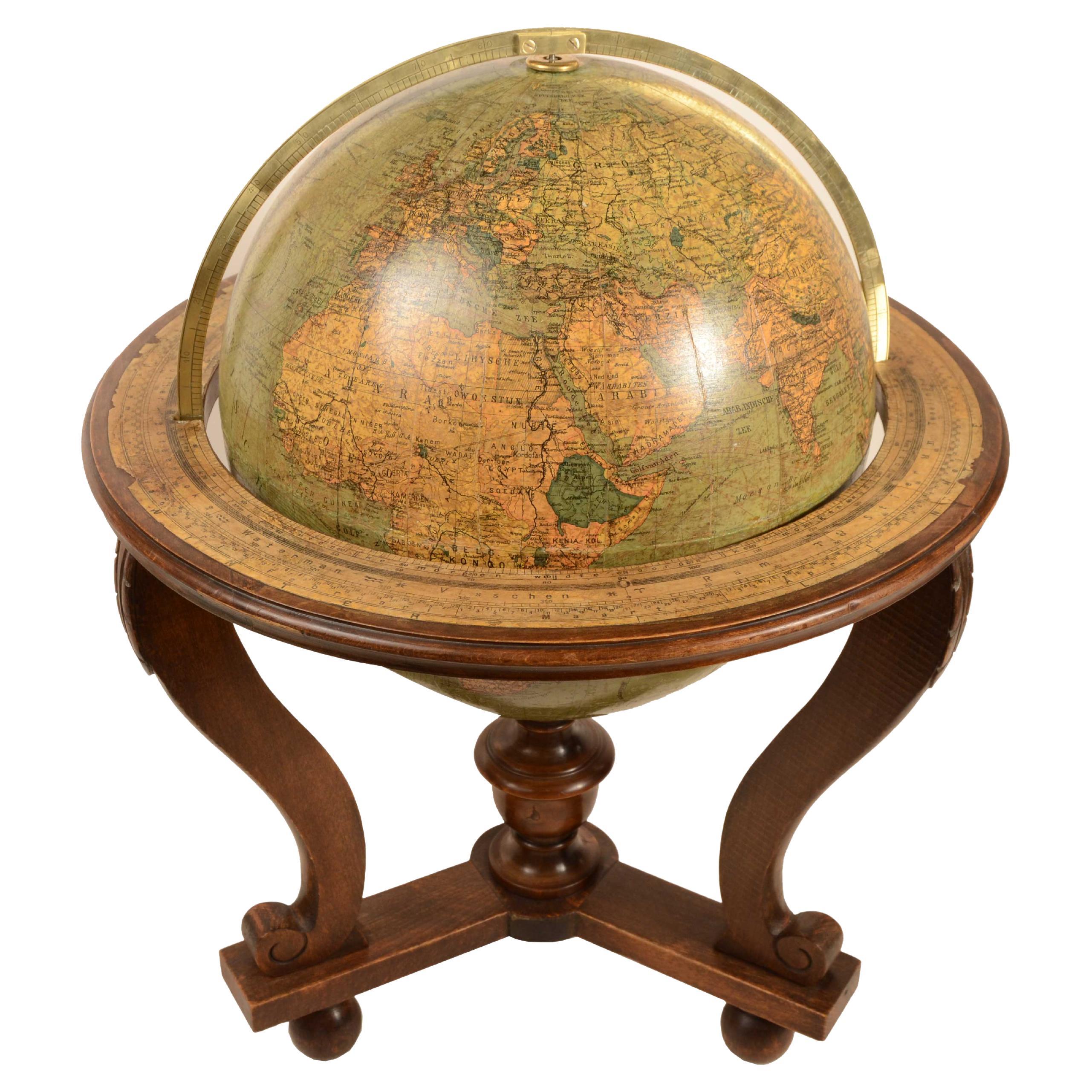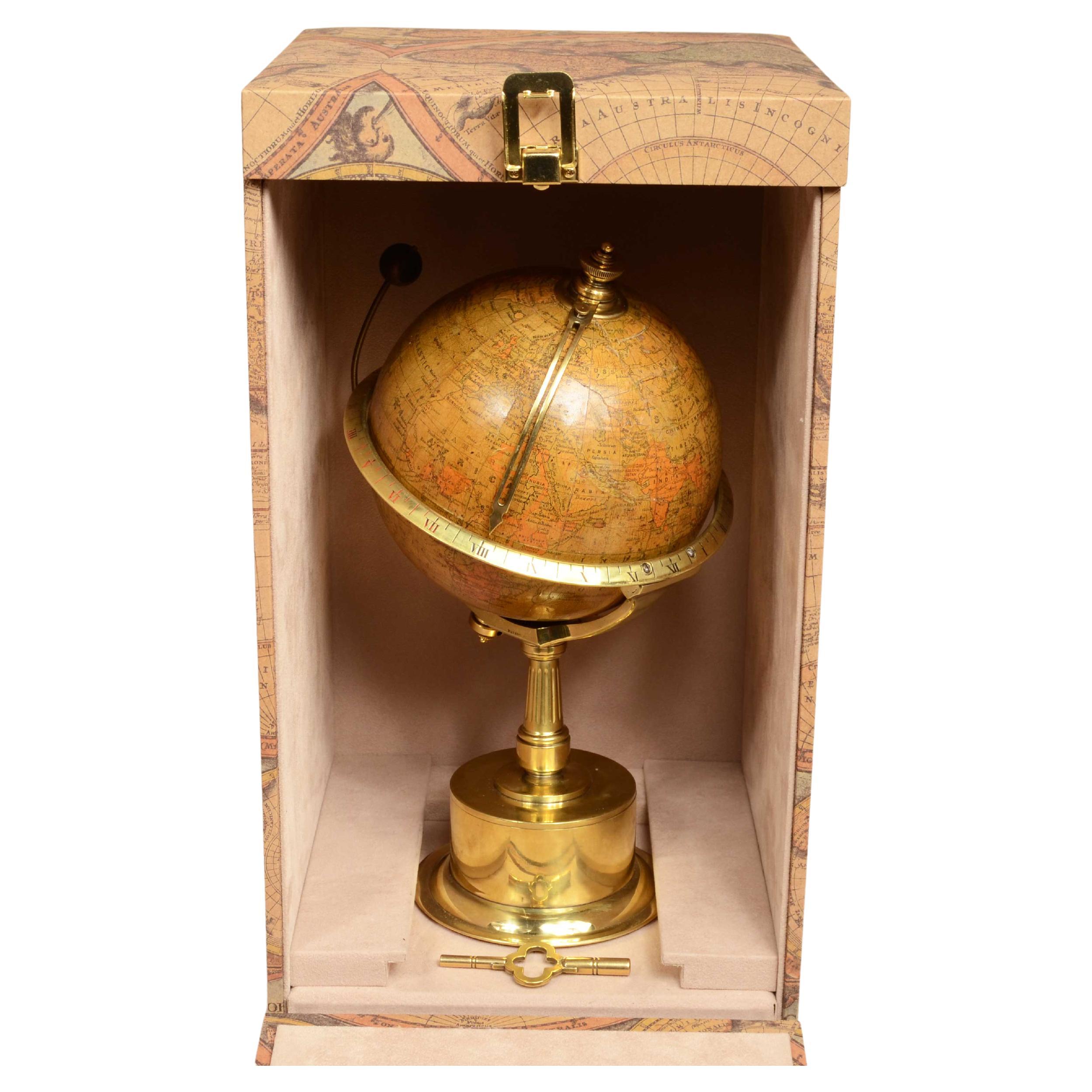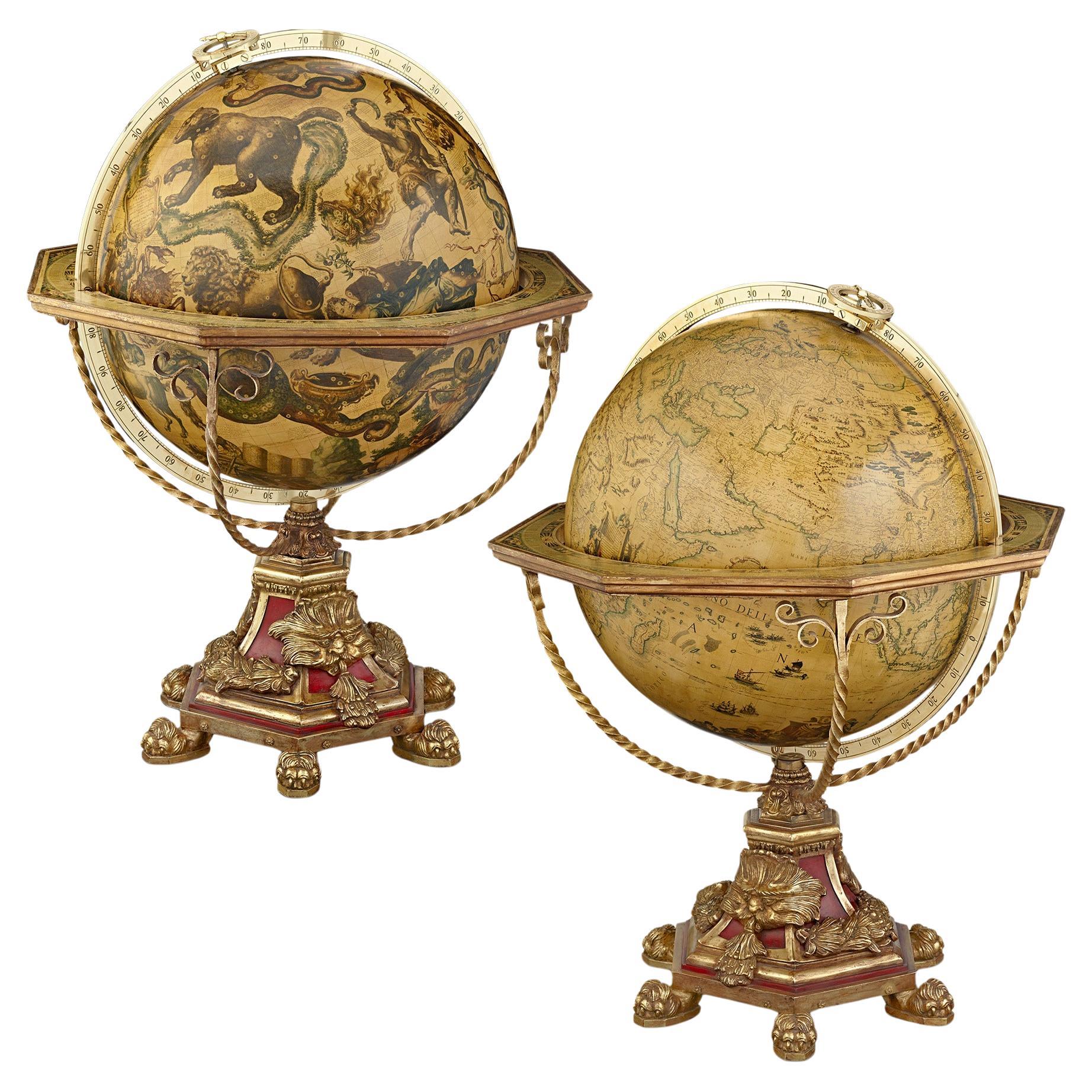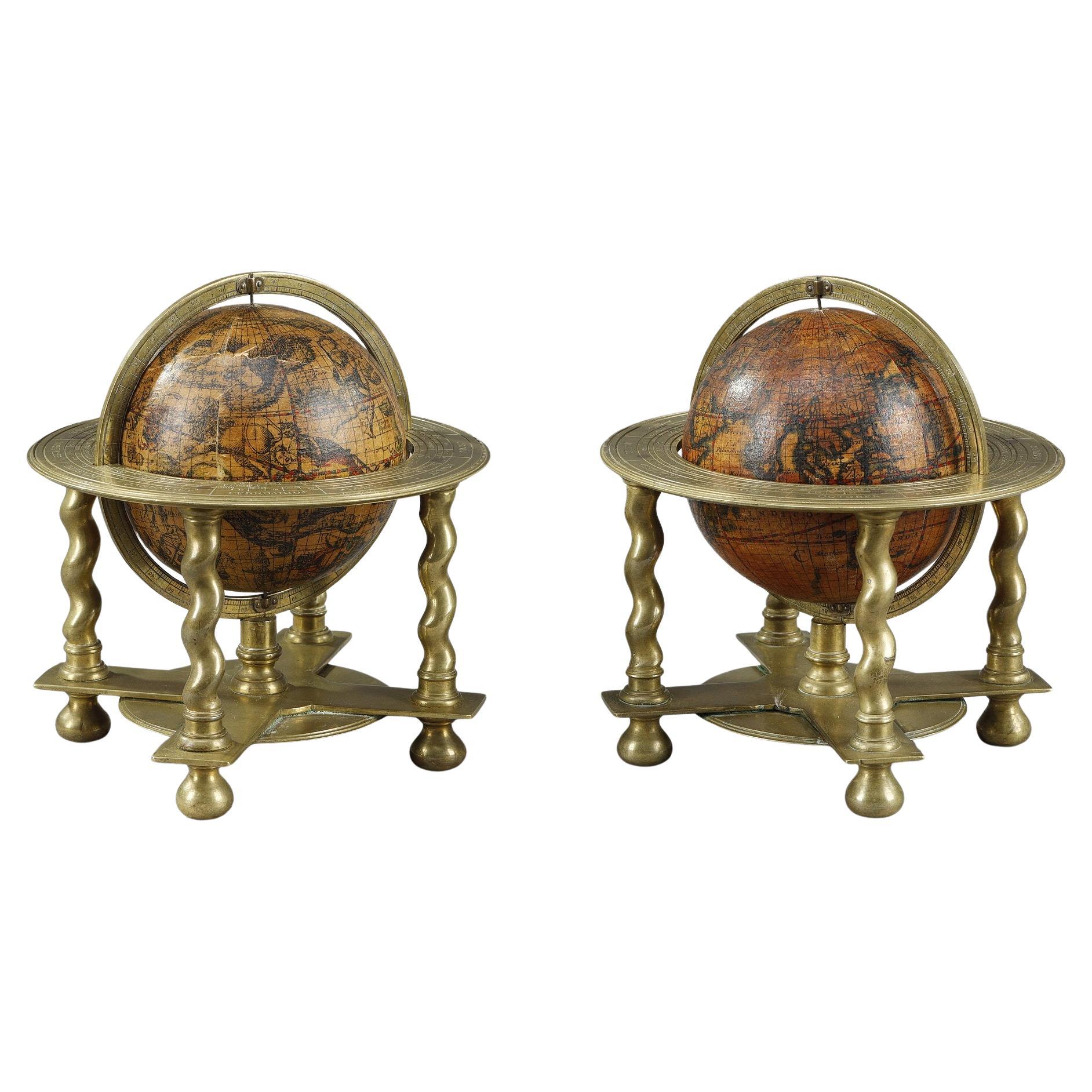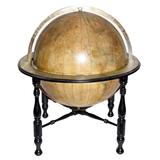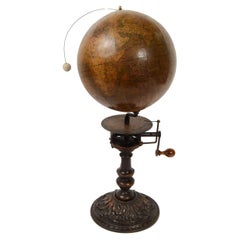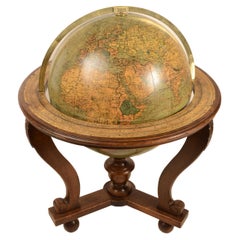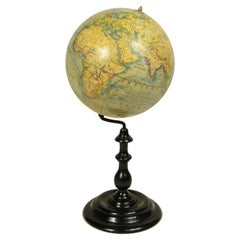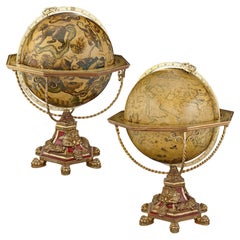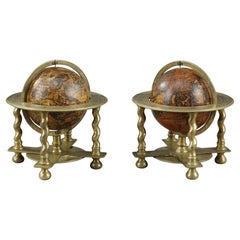Items Similar to Very rare pair of terrestrial and celestial globes by Felix Delamarche dated 1834
Want more images or videos?
Request additional images or videos from the seller
1 of 21
Very rare pair of terrestrial and celestial globes by Felix Delamarche dated 1834
$33,372.36
£24,712.03
€28,000
CA$45,892
A$51,043.69
CHF 26,715.18
MX$622,564.74
NOK 335,685.91
SEK 315,755.93
DKK 213,172.63
About the Item
Very rare pair of terrestrial and celestial globes made by Felix Delamarche in 1834. The cartouche of the globe reads Globe Terrestre Dressé par Felix Delamarche 1834. Plaster and paper papier mache balls, turned and ebonized wooden basket bases complete with the meridian and equator circle and papier mache hour circle. Good condition, excellent readability, conservative restorations.
Height 40 cm - 15.8 inches, base diameter 27 cm - 10.6 inches, sphere diameter 18 cm - 6.9 inches.
The globe is written in French and has cream-colored oceans and continents. Coastal lines are outlined with dashes and highlighted in brown. Mountain ranges are pictorially represented. The equator and ecliptic are highlighted in red. The oceans are marked with dotted lines called "Division Océanique."
Alaska is called Amerique Russe - Russian America, while Australia is called Nouvelle Hollande - New Holland, and Tasmania is depicted as an island and referred to as I. de Diemen - Diemen Island.
Antarctica is not mapped but only indicated as Ocean Glacial Antarctique which reflects the geographical knowledge of the time.
The celestial globe consists of 12 spindles of paper printed from copper plate engraving depicting le constellations of the globe and symbolize figures of animals, mythological characters and scientific instruments on a cream-colored background.
Founder of this important astronomical instrument maker was geographer Charles - François Delamarche (1740 - 1817). The firm was initially based at rue de Foin St Jacques in the Latin Quarter of Paris, where it remained until 1805, moving to 13 rue de Jardinet. Upon the death of Charles - François in 1817 the reins of the enterprise were taken over by his son Felix, who continued a prolific production, partly through cooperation with engraver Charles Dien. Around 1835 the firm was moved to 7 rue du Battoir, and then to 25 rue Serpente. In addition to terrestrial and celestial spheres, the Delamarche also distinguished themselves by producing other astronomical instruments, such as armillary spheres, named after the circles (Latin for "armillae") that represented the various planets in the solar system.
The earliest known globe is the one attributed by Strabo, a historian and geographer, to the Greek Cratetes of Mallo (c.a. 150 B.C.). The first globes in the early 16th century were built under the impetus of the great geographical explorations. In the 18th century, the official geographer of Louis XV King of France, Didier Robert de Vaugondy, thanks to the practice he had gained in globe making, expanded the "Globe" article of the Encyclopédie by detailing the distinction between a celestial globe (representing the concave surface of the sky with its constellations) and a terrestrial globe (representing instead the surface of the Earth with its seas, islands, rivers, cities, etc.) and the techniques for making them: two papier-mâché hemispheres covered with a thin layer of plaster to which paper spindles previously printed by copperplate engraving and colored were glued. It will be with the nineteenth century of great commerce and the introduction of compulsory schooling that spindles printed from engraved plates will no longer suffice, and the only real resource will be lithography through which it is possible to print and update maps in a timely manner, which as more and more geographical discoveries are made in different countries become obsolete more and more rapidly.
The Paris meridian was defined on June 21, 1667 by mathematicians of the Académie, but the measurement of the meridian was not completed until 1718 by Giovanni Domenico Cassini and his son Jacques Cassini. In 1740, César-François Cassini rectified the track and then the meridian was measured again from 1792 to 1798 by Jean-Baptiste Joseph Delambre and Pierre Méchain as the basis for establishing the exact length of the meter in 1799. The Paris meridian was abandoned in favor of the Greenwich meridian during the 1884 Washington International Conference. Some of the reasons were that there was almost no inhabited land at the antipodes of Greenwich, the British promise to adopt the metric system in exchange for the French relinquishing the Paris meridian, and the fact that at the time most nautical cartography was of English origin and therefore adopting a meridian other than Greenwich would force the replacement of more nautical charts. In France, the Greenwich meridian was not officially adopted until 1911.
The first globes in the early 16th century were built under the impetus of the great geographical explorations and immediately began to be used for educational purposes at princely courts, monasteries and colleges. In the 18th century, the official geographer of King Louis XV of France, Didier Robert de Vaugondy, thanks to the practice he had gained in globe making, expanded the "Globe" article of the Encyclopédie by explaining in great detail the difference between a celestial globe (representing the concave surface of the sky with its constellations) and a terrestrial globe (representing instead the surface of the Earth with its seas, islands, rivers, cities, etc.) and the techniques for making them: two papier-mâché hemispheres pressed and molded on or inside a hemispherical mold, allowed to dry and reinforced inside with a wooden board, then glued together and covered with a thin layer of plaster on which the globe spindles of areas between two meridians, usually twelve, each covering 30 degrees of longitude, made of paper that had previously been printed by engraving on a copper plate and then colored, were pasted.
About the Seller
5.0
Gold Seller
Premium sellers maintaining a 4.3+ rating and 24-hour response times
Established in 1999
1stDibs seller since 2014
398 sales on 1stDibs
Typical response time: 1 hour
- ShippingRetrieving quote...Shipping from: Milan, Italy
- Return Policy
Authenticity Guarantee
In the unlikely event there’s an issue with an item’s authenticity, contact us within 1 year for a full refund. DetailsMoney-Back Guarantee
If your item is not as described, is damaged in transit, or does not arrive, contact us within 7 days for a full refund. Details24-Hour Cancellation
You have a 24-hour grace period in which to reconsider your purchase, with no questions asked.Vetted Professional Sellers
Our world-class sellers must adhere to strict standards for service and quality, maintaining the integrity of our listings.Price-Match Guarantee
If you find that a seller listed the same item for a lower price elsewhere, we’ll match it.Trusted Global Delivery
Our best-in-class carrier network provides specialized shipping options worldwide, including custom delivery.More From This Seller
View AllHandcrafted mechanical lunarium with cast iron base, second half of the 19th cent
Located in Milan, IT
Handcrafted mechanical lunarium with cast iron base, second half of the 19th century, surmounted by a globe made by cartographer Jan Felkl. Turning the crank placed under the circle...
Category
Antique 1870s Globes
Materials
Metal
German Columbus terrestrial globe for the Dutch market early 20th century
Located in Milan, IT
Earth globe published for the Dutch market in the early 20th century by the Columbus publishing house, the cartouche reads: Dr. R. Neuse's Aardglobe. Nederlandsche bewerking van R.E....
Category
Antique Early 19th Century Globes
Materials
Paper
Earth globe complete with 8-day winding clock and moon phase late 1800s
Located in Milan, IT
Earth globe complete with moon phase clock with sphere that rotates over 24 hours and the time is indicated by a brass hand, eight-day charge. French manufacture for the English mark...
Category
Antique Late 19th Century Globes
Materials
Brass
Globe of the cartographer geographer of the Austro-Hungarian Empire Jan Felkl of 1870
Located in Milan, IT
Tabletop globe made by Austro-Hungarian Empire geographer and cartographer Jan Felkl in the second half of the 19th century.
In addition to the spatial map, ocean currents are shown...
Category
Antique 1870s Globes
Materials
Paper
Earth globe of the geographer and cartographer of the Austro-Hungarian Empire Jan Felkl
Located in Milan, IT
Tabletop globe made by Austro-Hungarian Empire geographer and cartographer Jan Felkl in the second half of the 19th century. In addition to the spatial map, ocean currents are shown....
Category
Antique 1870s Globes
Materials
Paper
Earth globe edited Räths Politischer Erdglobus drawn and outlined in 1930
Located in Milan, IT
Earth globe edited by Räths Politischer Erdglobus drawn and delineated by Porf Arthur Krause in the 1930s, in addition to the spatial map, ocean currents and major trade routes of th...
Category
Vintage 1930s Globes
Materials
Paper
You May Also Like
Pair of 32" Terrestrial and Celestial Globes
Located in New Orleans, LA
Pair of Terrestrial and Celestial Globes
G & T London
20th Century
This extraordinary pair of 32-inch terrestrial and celestial globes, crafted by G & T London, pays homage to the m...
Category
20th Century English Scientific Instruments
Materials
Metal
Pair of rare 17th century celestial and terrestrial globes, Vincenzo Coronelli
By Vincenzo Coronelli
Located in Paris, FR
Pair of celestial and terrestrial table globes, wooden globe covered with engraved and enhanced paper spindles. Bronze mounts with two rings featuring a horizon table engraved with a...
Category
Antique 1690s Italian Globes
Materials
Wood
Large Terrestrial Library Globe
Located in Nashville, TN
30 inch diameter library globe featuring Oklahoma with Indian territory, circa 1890. Maker is Johnston, Edinburgh, Scotland, a renowned British globe pro...
Category
Antique Late 19th Century Scottish Globes
Materials
Brass
Monumental Italian Renaissance Globe
Located in Queens, NY
Monumental Italian Renaissance-style (19/20th century) globe of world on 6 spool leg base.
Category
20th Century Renaissance Globes
Materials
Wood
Terrestrial Table Globe by Félix Delamarche, Paris, 1821
By Félix Delamarche
Located in Milano, IT
Terrestrial table globe
Félix Delamarche
Paris, 1821
It measures 20.47 in height, Ø max 14.17 in; the sphere Ø 9.44 in (h 52 cm x Ø max 36.5 cm; the sphere Ø 24 cm)
Wood, printed...
Category
Antique 1820s French Restauration Scientific Instruments
Materials
Metal
A pair of celestial and terrestrial globes, E.Pini, Gussoni & Dotti, Italy 1892.
Located in Milan, IT
Pair of Italian globes. On an ebonized wooden base, worked on the lathe, with a circular foot and perfect patina, are placed: a celestial globe of 9,2 inches, compiled by the enginee...
Category
Antique 1890s Italian Scientific Instruments
Materials
Wood
More Ways To Browse
Rosso Francia
Weber Costello
Pearsall Globe
Rand Mcnally Terrestrial Globe
Adrian Pearsall Globe
Arthur Krause
Denoyer Geppert Globe
Repogle Globe
Denoyer Geppert Chalk Globe
Globus Table
Gustav Brueckmann
Homer Costello
Malby Globe
Nystrom World Globes
Replogle Globe 1970 S
Columbus Duo Globe
Gilman Joslin Terrestrial Globe
Replogle Globe Teak
